Limelight hydrangeas are a hit in landscaping across North America. They’re known for their large, eye-catching flowers. These flowers start green, turn white, and then show off pink, red, and burgundy colors as they age.
Gardeners love them for their size, long bloom time, and ability to grow in many climates. In this article, I’ll share how these hydrangeas can grow and how to take care of them.
Introduction to Limelight Hydrangeas
Planting and Caring for Limelight Hydrangeas
Limelight hydrangeas are a favorite among gardeners for their beautiful panicle-shaped flowers. They come from the Netherlands and are now loved in gardens across the U.S. Taking care of these plants is easy, as they need well-drained soil and plenty of sunlight.
For the best growth, consider your hydrangeas’ light and soil needs. They like at least six to eight hours of sunlight a day. They can handle some shade, especially in hot places. The ideal soil is rich, well-drained, but they’re flexible and can adjust to different soils.
Good care helps limelight hydrangeas grow well. Feed them a balanced fertilizer, like rose food, in early spring. This boosts growth and flower production. Prune them in early spring to cut back by one-third. This makes the stems stronger and the plant looks better.
With the right spot and care, limelight hydrangeas can flourish for many years. Their flowers change from white to pink, red, and burgundy with the seasons. These plants are easy to grow and add beauty to any garden or landscape.
Limelight Hydrangea Growth Rate
Thinking about adding a limelight hydrangea to your garden? These plants grow fast. They are known for their quick growth, often called the “sleep, creep, leap” pattern.
In the first year, a limelight hydrangea seems to “sleep” as it builds a strong root system. By the second year, it starts to “creep,” growing slowly. By the third year, it “leaps” and grows fast, reaching its full size quickly.
This quick growth makes limelight hydrangeas a favorite for landscaping and gardens. They can grow over 6 feet tall in three years. They can get about 10 feet tall and spread 5 feet wide when fully grown.
Limelight hydrangeas grow about 1-2 feet each year. This makes them one of the fastest hydrangea types. They’re perfect for making a big impact in your outdoor areas fast.
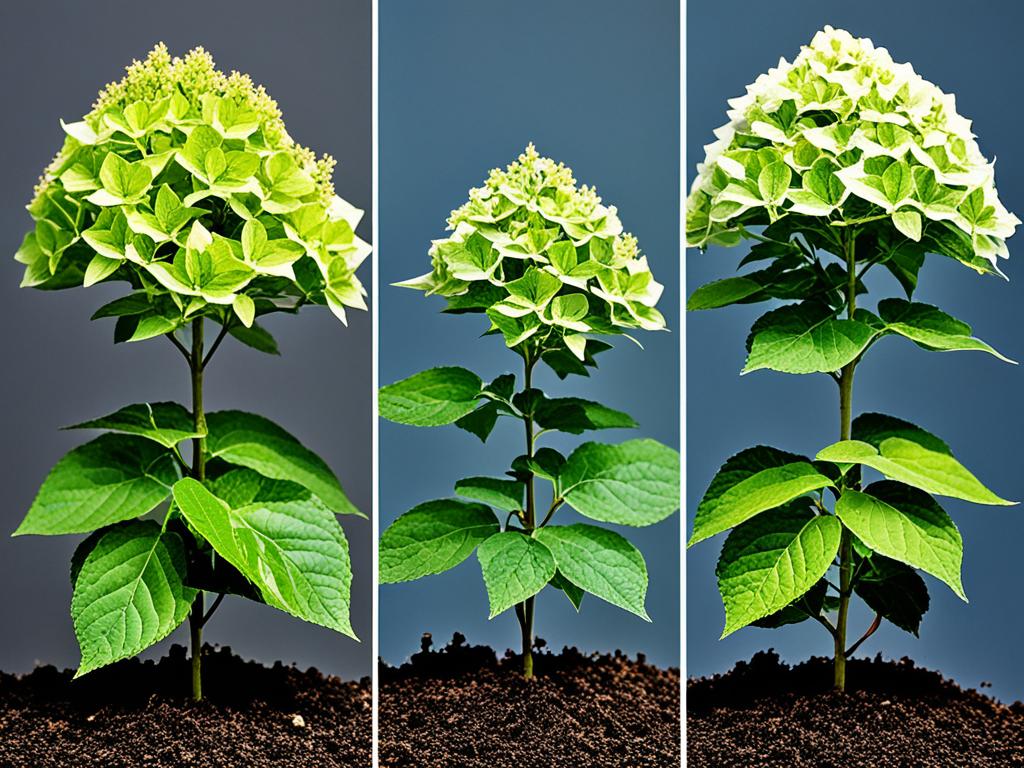
“Limelight Hydrangeas are known for their rapid growth rate, often reaching their mature size in just a few years.”
Looking to highlight your garden or create a beautiful privacy hedge? The limelight hydrangea’s fast growth will surely catch everyone’s eye.
Mature Height and Width of Limelight Hydrangeas
Limelight hydrangeas stand out with their size and bold presence in gardens. They can grow 6 to 8 feet tall and wide. The size of a limelight hydrangea changes based on its environment, but it’s a big type in the panicle hydrangea family.
Limelight Hydrangea Dimensions
Some limelight hydrangeas are bred to be smaller. For instance, the “Little Lime” grows 3 to 5 feet tall and wide. It’s great for small gardens or pots. The “Limelight Prime” is taller, reaching 4 to 6 feet high and 4 to 5 feet wide. It’s a good choice between the full-size and dwarf varieties.
| Hydrangea Variety | Mature Height | Mature Width |
|---|---|---|
| Limelight | 6-8 feet | 6-8 feet |
| Limelight Prime | 4-6 feet | 4-5 feet |
| Little Lime | 3-5 feet | 3-5 feet |
Limelight hydrangeas are famous for their big, noticeable blooms. These can be up to 12 inches long. Their large, cone-shaped flowers are a beautiful sight in any garden or landscape.
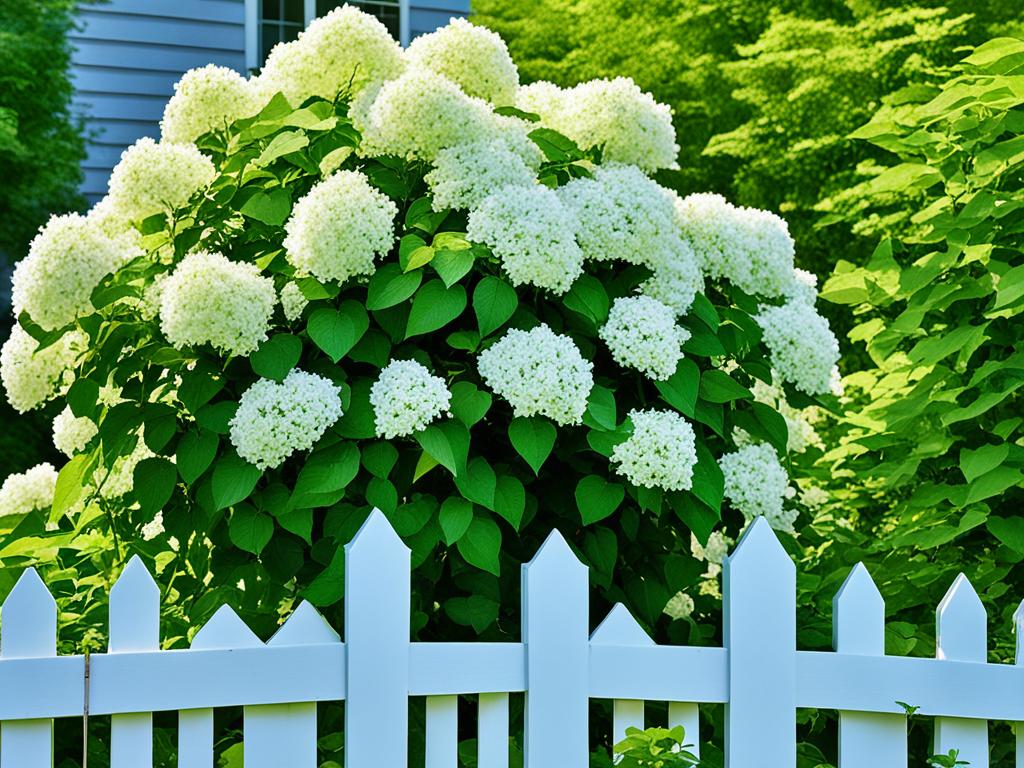
How big does a limelight hydrangea get?
Limelight hydrangeas are known for their impressive size and dramatic look. They can grow up to 6 feet tall and spread 8 feet wide. Their large, lush flowers change color from green to white, pink, and burgundy with the seasons. A mature Limelight hydrangea is a must-see in any garden.
For those with smaller gardens, the Limelight Prime® hydrangea is a great choice. It grows 4-6 feet tall and 4-5 feet wide. This variety blooms early, giving you more time to enjoy its beauty.
| Hydrangea Variety | Mature Height | Mature Width | Spacing Recommendation |
|---|---|---|---|
| Limelight Hydrangea | 6-8 feet | 6-8 feet | 6-8 feet apart |
| Limelight Prime® Hydrangea | 4-6 feet | 4-5 feet | 4-5 feet apart |
Choosing any Limelight hydrangea will add beauty and drama to your garden. Their size and long-lasting blooms make them a standout. They’re perfect for anyone looking to enhance their outdoor space.
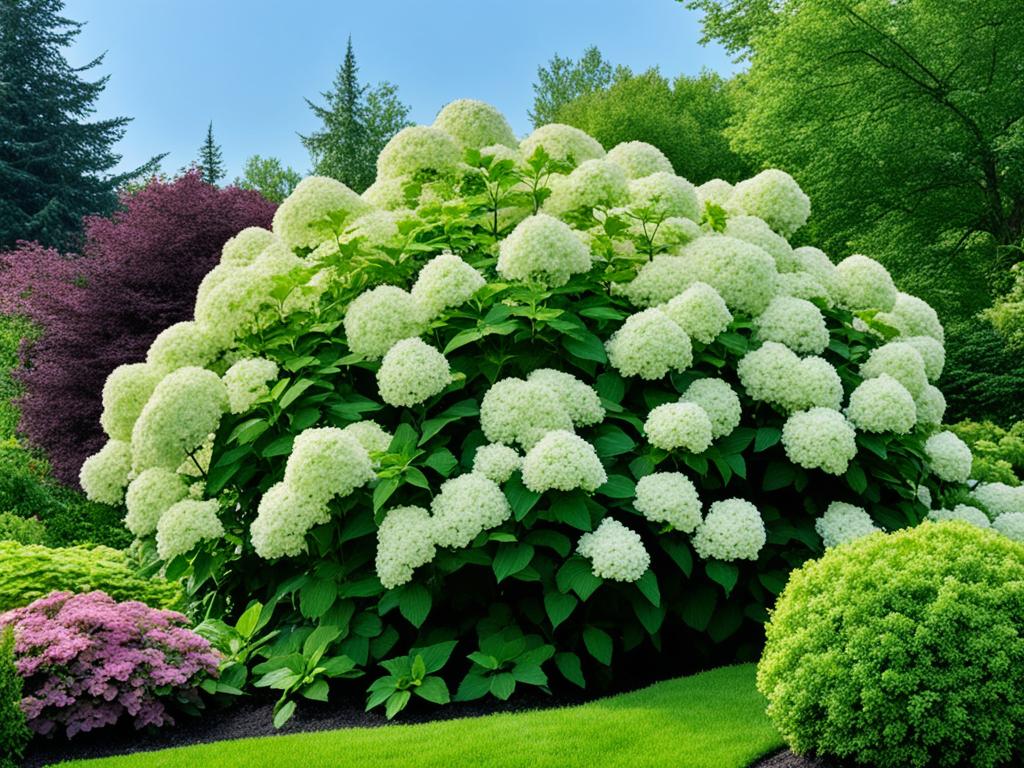
Limelight Hydrangea Sunlight Needs
The right amount of sunlight is key for the limelight hydrangea’s health and bright blooms. These shrubs do well in full to partial sun, needing at least 6 hours of direct sunlight daily for the best growth.
Optimal Light Conditions for Limelight Hydrangeas
In cooler areas, like USDA zones 3-6, limelight hydrangeas handle full sun just fine. But in warmer zones (7-9), mix morning sun with afternoon shade. This prevents stress and damage from the midday heat.
For limelight hydrangeas, the best light is a mix of sunlight and shade. This balance lets the plants get enough rays without getting too much UV. By doing this, you help your limelight hydrangeas bloom well and stay healthy.
| USDA Zone | Optimal Sunlight Exposure |
|---|---|
| 3-6 | Full Sun |
| 7-9 | Partial Sun (Morning Sun, Afternoon Shade) |
Getting the right amount of limelight hydrangea sunlight is key for their health and blooms. Knowing the limelight hydrangea light requirements helps you create the best conditions for these beautiful plants.
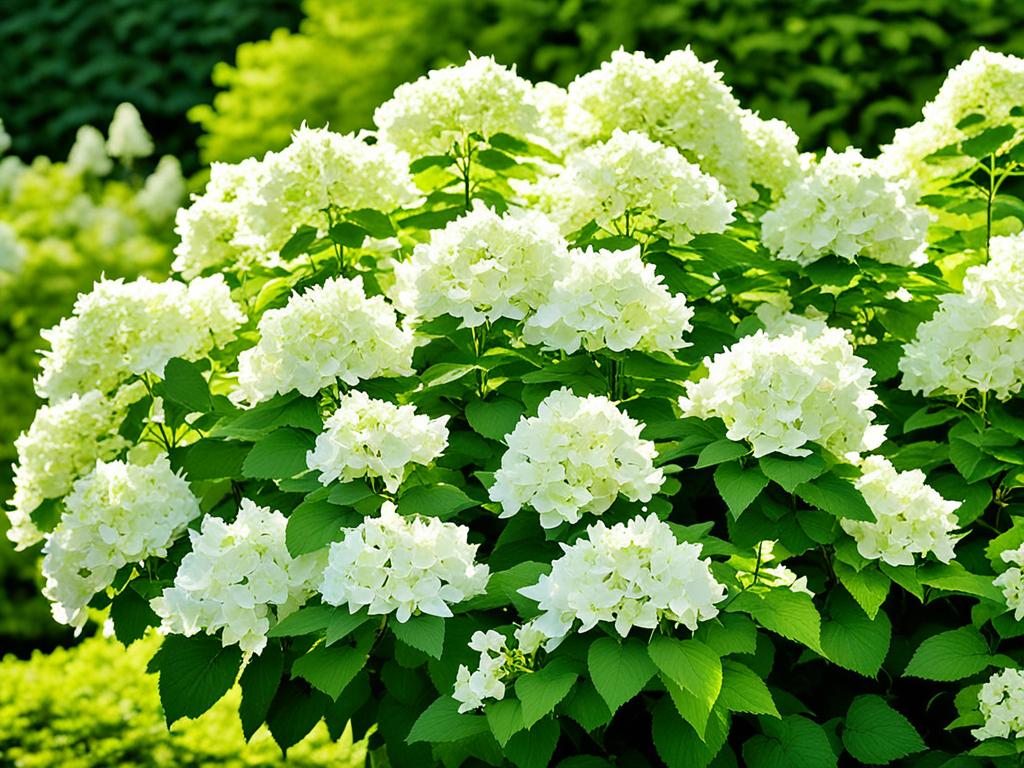
Limelight Hydrangea Pruning
Proper pruning is key to keeping your limelight hydrangeas looking great and full of blooms. The best time to prune is early spring, late winter to early spring. Cut the plant back by about one-third of its height to encourage new growth.
This method makes the stems stronger and helps new growth come from larger buds. Removing thin or dead branches is also a good idea.
Pruning like this keeps your hydrangeas in shape and ensures they bloom well. Lorraine Ballato, a well-known horticulturist, recommends pruning in late fall, winter, or early spring when the plant is dormant.
If your area has harsh winters, wait until spring to prune your hydrangeas. This way, you avoid over-pruning by considering any winter damage.
Pruning Panicle Hydrangeas
Limelight hydrangeas are panicle hydrangeas, which means they bloom on new growth. Prune them in late winter or early spring to make sure they bloom well this year.
When pruning, cut off 30%-50% of the old growth before new buds form. This makes the plant fuller and more compact, leading to more blooms.
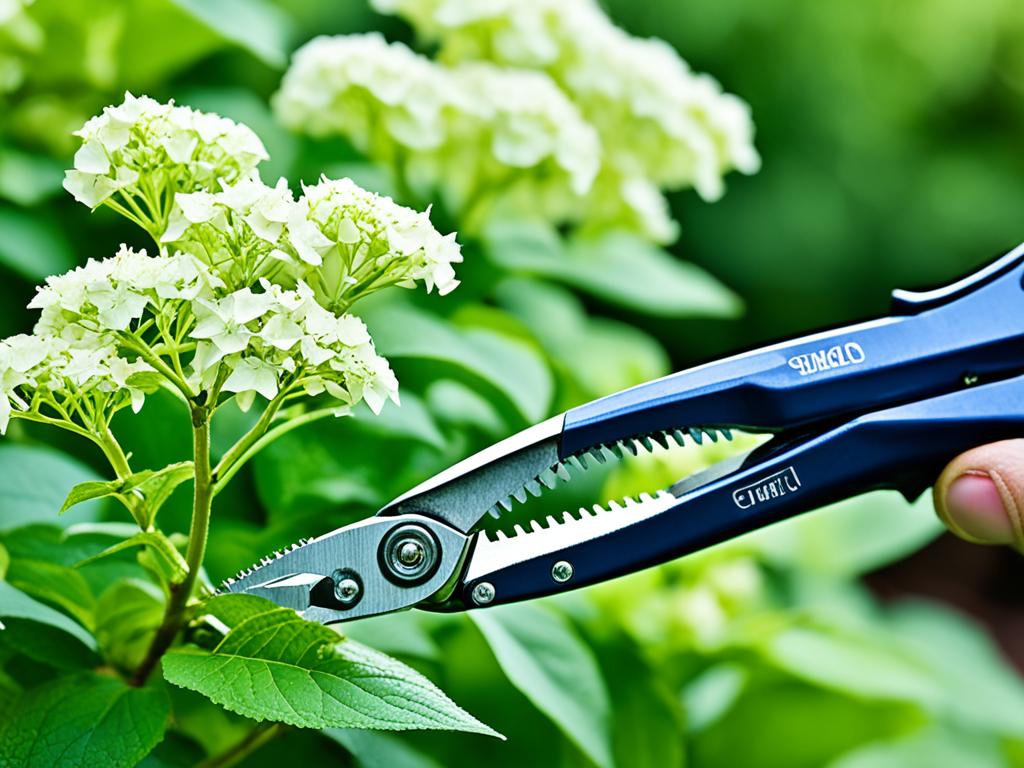
By pruning your limelight hydrangeas this way, they’ll stay healthy, full, and blooming beautifully every year.
Heat and Drought Tolerance of Limelight Hydrangeas
Limelight hydrangeas are known for their great heat and drought tolerance. They are perfect for gardeners in sunny, warm areas. These plants can grow well in USDA hardiness zones 3 through 9, even in the hottest spots.
Limelight hydrangeas need regular water but can handle drought once they’re established. In hot places, give them some afternoon shade and keep the soil moist but not too dry. They are very tough and can do well in tough conditions.
Caring for Limelight Hydrangeas in Hot Climates
To help limelight hydrangeas thrive in hot climates, follow these tips:
- Provide afternoon shade, especially during the hottest hours of the day
- Maintain consistent soil moisture, but avoid overwatering
- Apply a thick layer of organic mulch around the base of the plant to retain moisture
- Fertilize with a balanced, slow-release fertilizer in early spring
- Prune limelight hydrangeas in late winter or early spring to encourage new growth
By understanding the heat and drought tolerance of limelight hydrangeas and following these tips, you can enjoy their beautiful flowers even in the hottest places.
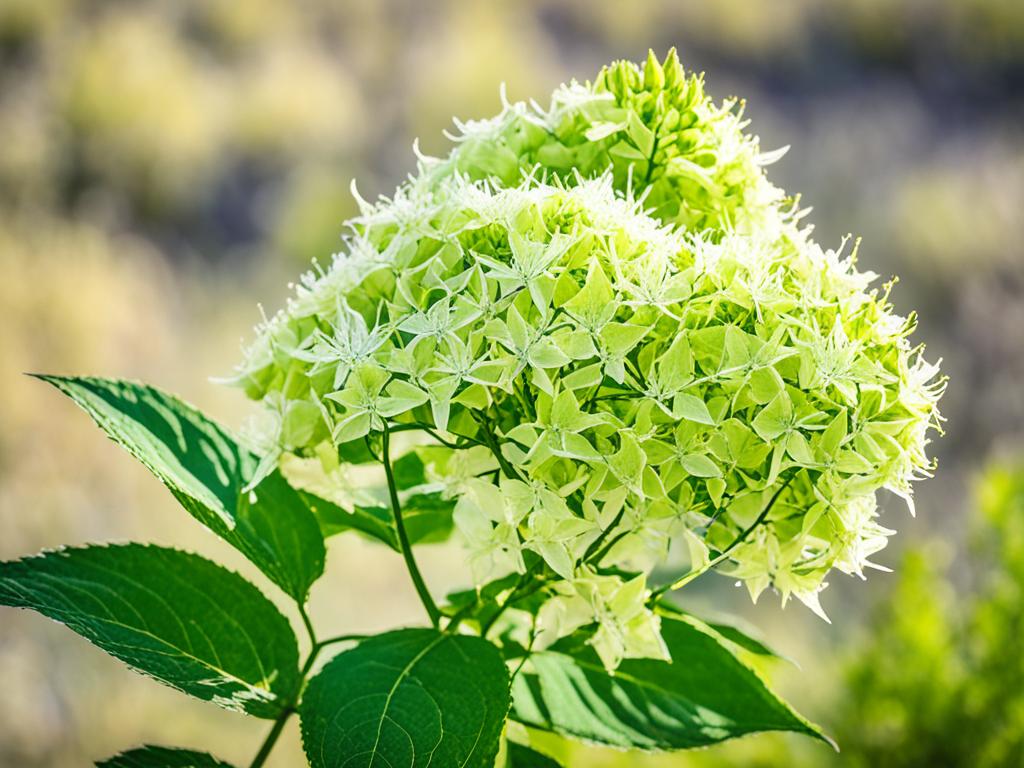
Bloom Time and Color of Limelight Hydrangeas
Limelight hydrangeas are famous for their long bloom time, from mid to late summer. Their flowers start green, turn creamy white, and then show off pink, red, and burgundy colors. This change is a key feature of the limelight hydrangea, not affected by soil type or other conditions.
The blooms last for several months, making the garden look stunning into the fall. These plants are known for their reliable, beautiful flowers every year. They are a favorite among gardeners and flower lovers.
- Limelight hydrangeas produce cone-shaped, panicled flowers that progress from spring to the fall season.
- The flowers transition from soft white to light green to mostly white and puffy during summer, then turn pale pink and eventually mauve pink and pale green in the fall.
- Limelight hydrangea flowers are massive and hold up well into the fall season, making beautiful dried garden decor.
- These hydrangeas surprise with new blooms even in October, extending their visual appeal well into the autumn months.
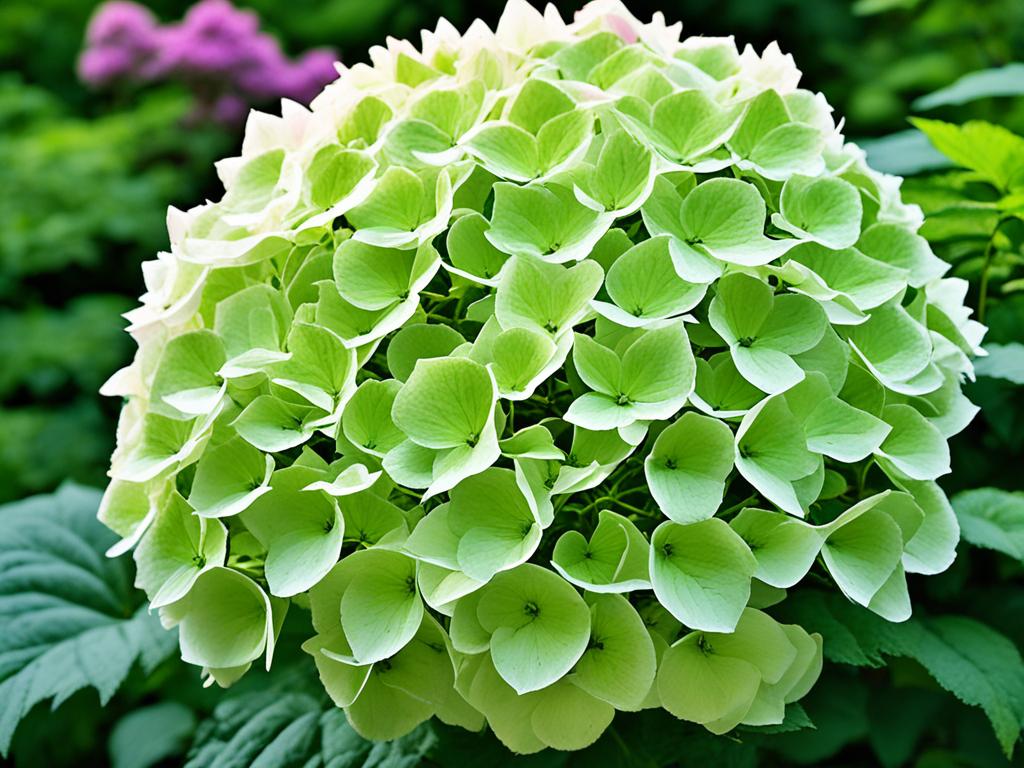
“Limelight hydrangeas are a reliable performer, offering consistent, eye-catching flowers year after year.”
Limelight Hydrangea as Cut Flowers
Limelight hydrangeas are not just big and bloom for a long time in gardens. They also make great cut flowers. Their big, beautiful flowers are perfect for fresh or dried floral arrangements. When taken inside, these blooms can last for weeks, adding beauty to any room.
Limelight hydrangeas are versatile. They dry well, keeping their bright colors after the blooming season. Dried limelight hydrangea flowers are great for autumn and winter decor. They add a natural touch that makes any room look better.
Fresh and Dried Limelight Hydrangea Arrangements
Limelight hydrangeas are loved by florists and gardeners. Their big, beautiful blooms and strong stems are great for making stunning arrangements. They can be used fresh or dried and fit well in many designs, from elegant bouquets to rustic wreaths.

“Limelight hydrangeas are a constant favorite among our customers. The flowers are so versatile – they look beautiful in both fresh and dried arrangements.”
– Sarah, a local florist
If you want to brighten up your home or make a centerpiece, think about using limelight hydrangea flowers. They last a long time and look beautiful, making any floral project stand out.
Landscaping with Limelight Hydrangeas
Limelight hydrangeas are a great choice for making your outdoor spaces look beautiful. They can be used in many creative ways to improve your landscape design. Let’s look at some top ways to add limelight hydrangeas to your garden plans.
One great way to use limelight hydrangeas is as a specimen plant. Their big, eye-catching flowers can be the main attraction in a garden bed or border. By placing a single limelight hydrangea in a key spot, you let its beauty stand out.
Limelight hydrangeas are also perfect for flowering hedges. They bloom reliably and fit well along property lines or walkways, offering privacy and beauty. Planting a line of them creates a colorful, living barrier.
Another way to use limelight hydrangeas is in mixed borders and beds. Their full foliage and bright flowers work well with many other plants, making your garden look lively and interesting.
| Limelight Hydrangea Varieties | Size |
|---|---|
| ‘Limelight’ Hydrangea | 6 to 8 feet tall and wide |
| Limelight Prime® Hydrangea | 4 to 6 feet tall and 4 to 5 feet wide |
| Little Lime® Hydrangea | 3 to 5 feet tall and wide |
However you decide to use limelight hydrangeas, they’re sure to make a statement. Their consistent blooms, flexibility, and beautiful look will enhance any outdoor area.
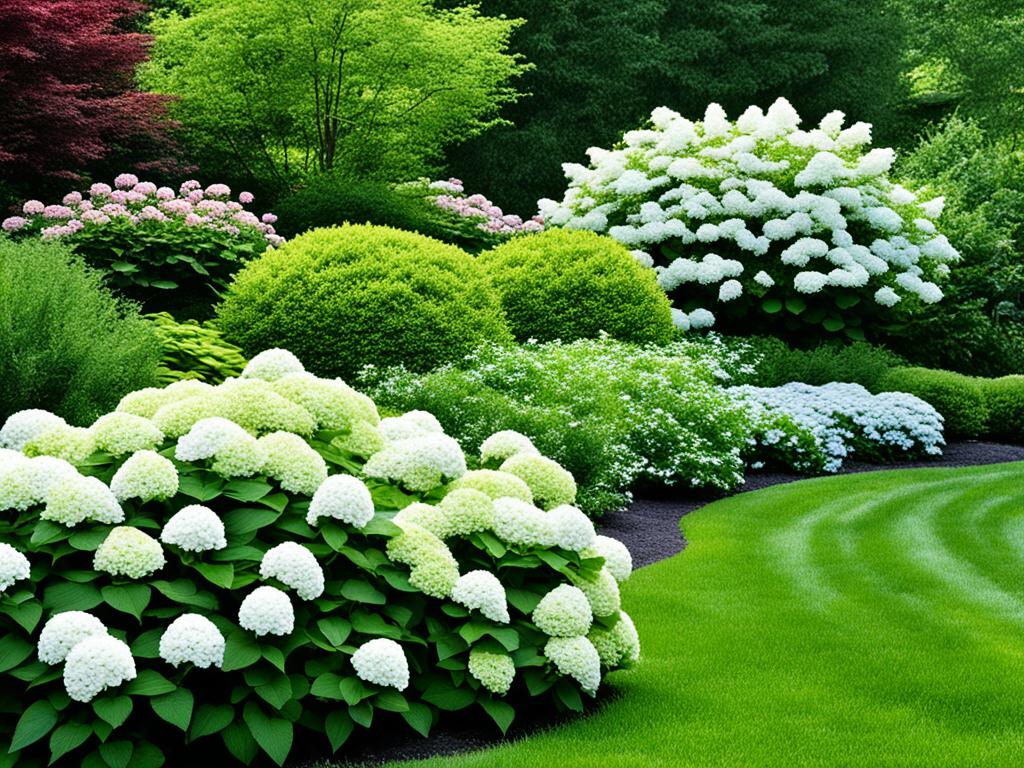
Comparison with Other Hydrangea Varieties
The limelight hydrangea is a top choice, but there are many other hydrangeas with their own perks. They stand out for their big flowers, bright colors, and ability to handle heat and drought well.
Dwarf Limelight Hydrangea Cultivars
For those with smaller gardens, the dwarf limelight hydrangeas are perfect. Varieties like “Little Lime” grow only 3 to 5 feet tall and wide. They’re great for small spaces or pots.
The standard limelight hydrangea is loved for its size and blooms. But, the dwarf types are perfect for gardens with limited room.
The Bobo® Hydrangea is a dwarf type, reaching 3 feet tall and 4 feet wide. It’s good for zones 3-8. The Strawberry Shake™ Hydrangea grows up to 5 feet tall and 4 feet wide, ideal for zones 4-8.
The Angel’s Blush® Hydrangea is bigger, reaching up to 12 feet tall and 10 feet wide. It’s best for zones 4-8.

Other hydrangeas worth noting include the bigleaf hydrangeas and smooth hydrangeas. These types are heat-tolerant and cold-hardy, surviving temperatures as low as -30°F. They’re perfect for zone 3 gardens.
Limelight Hydrangea Hardiness Zones
The limelight hydrangea is adaptable and strong, fitting many climates. It grows well in USDA hardiness zones 3 through 9, covering most of North America. In cooler zones (3-6), these hydrangeas do well in full sun. In warmer zones (7-9), they need some afternoon shade to avoid stress and leaf scorch.
Panicle hydrangeas, like the limelight type, are very cold and heat-tolerant. Almost 90% of North America can grow these hydrangeas, making them a good choice for many gardeners.
As long as the soil drains well and the plants get enough water, limelight hydrangeas will bloom and grow well. They are known for handling heat well, even in USDA zone 9.
| USDA Hardiness Zone | Limelight Hydrangea Suitability |
|---|---|
| 3-6 | Tolerates full sun |
| 7-9 | Performs best with some afternoon shade |
Limelight hydrangeas are versatile and dependable for gardeners in many climates. They offer beautiful blooms and a tall presence in gardens.

Soil and Fertilizer Requirements for Limelight Hydrangeas
Limelight hydrangeas are easy to care for when it comes to soil and fertilizer. They do well in soil that drains well and can handle a variety of soil types. From slightly acidic to slightly alkaline, they’re adaptable.
While limelight hydrangeas don’t need fertilizer, a balanced, rose-specific fertilizer in early spring can boost growth and blooms. This helps them grow strong and bloom more.
If your limelight hydrangeas show signs of nutrient deficiencies, like yellow leaves, you can add more fertilizer. Or, you can fix specific issues like iron or magnesium deficiency. Just make sure the soil drains well and stays moist, and these plants will do great with little extra help.
Addressing Nutrient Deficiencies in Limelight Hydrangeas
It’s key to watch for and fix nutrient deficiencies in your limelight hydrangeas. Look out for these common problems:
- Yellowing leaves: This could mean they lack nitrogen or iron. Fix this with a balanced fertilizer or iron.
- Stunted growth: If they’re not growing well or have small leaves, they might need more phosphorus or potassium. Use a fertilizer with more of these nutrients.
- Discolored foliage: Leaves turning purple or red could mean they’re low on magnesium. Epsom salts can help fix this.
By watching your limelight hydrangeas closely and fixing nutrient issues fast, you can keep them healthy. They’ll keep blooming beautifully year after year.
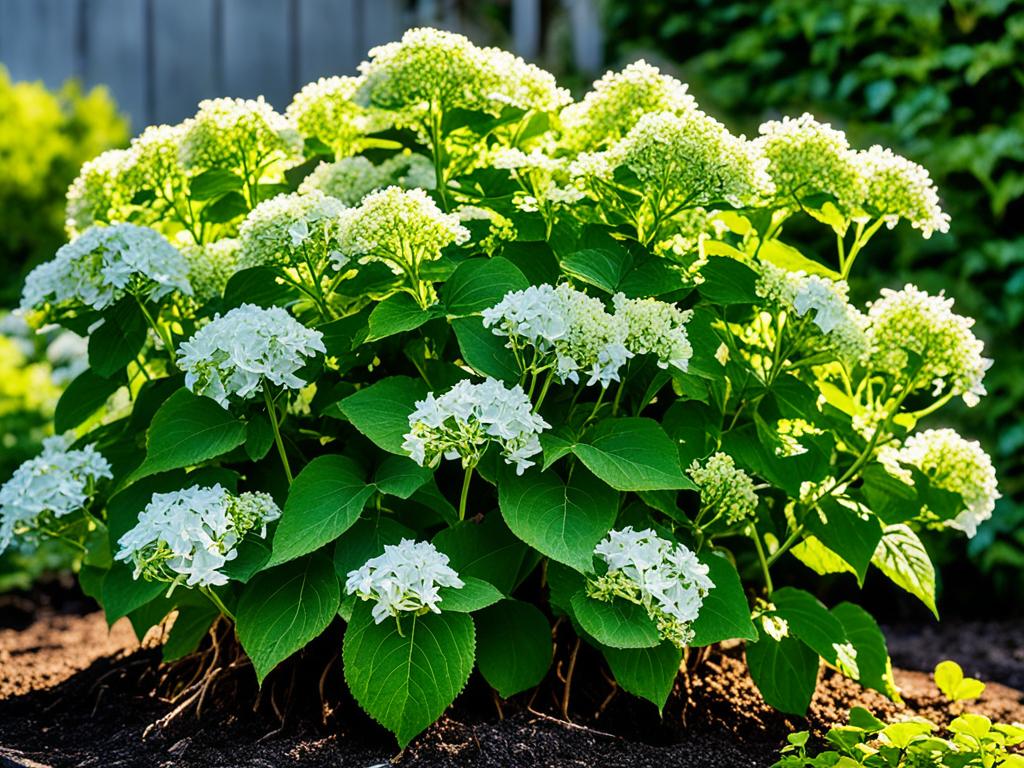
Pests and Diseases Affecting Limelight Hydrangeas
Limelight hydrangeas are tough and fight off most pests and diseases well. But, gardeners should watch out for a few common issues. Leaf spot fungus and insect pests like beetles are the main concerns.
Leaf spot fungus can make the leaves look bad, but it’s not a big deal for the plant’s health. Keeping the area clean by removing fallen leaves can stop this disease from spreading. Beetles might eat on the leaves, but this doesn’t harm the plant much.
Deer eating the flower buds can be a big problem, but you can protect young plants. With the right care, limelight hydrangeas are easy to keep up with and don’t face many issues.
- Leaf spot fungus can cause unsightly spots on foliage but is not a serious threat
- Insect pests like beetles may cause minor leaf damage
- Deer browsing on flower buds can be an issue, requiring physical protection
- Limelight hydrangeas are generally hardy and resistant to most common problems
With the right care and some prevention, gardeners can enjoy limelight hydrangeas’ beautiful flowers. Knowing the common problems and how to prevent them helps these plants flourish for many years.
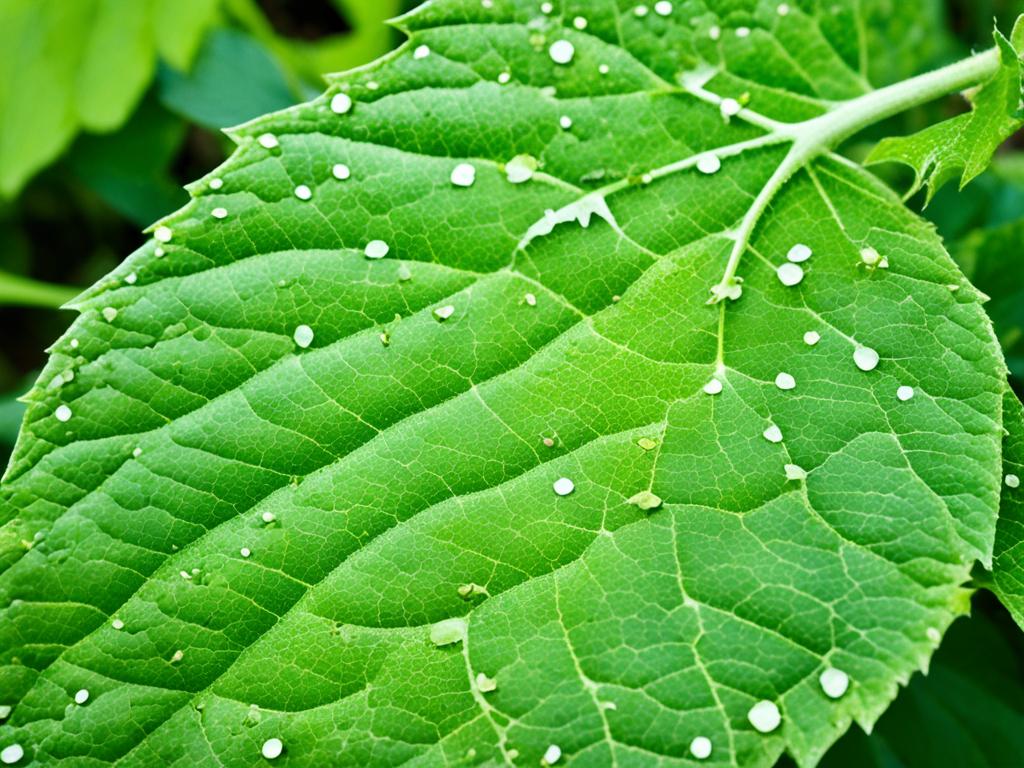
Conclusion
Limelight hydrangeas are a standout in any garden or landscape. They show off large, long-lasting blooms that change from green to various colors. These shrubs grow big and can be the main attraction. With the right care, they’re easy to maintain and fight off pests and diseases well.
These hydrangeas are great for many garden uses, like making a flowering hedge or adding to borders. They’re versatile and will make your garden look beautiful for years. Their size and care needs make them a great choice for gardeners.
When planning your garden, think about adding limelight hydrangeas. They’re tough, adaptable, and have beautiful flowers. These plants will quickly become a favorite part of your garden.
FAQ
How big do limelight hydrangeas get?
Limelight hydrangeas are a large type of panicle hydrangea. They grow to be 6 to 8 feet tall and wide.
What are the dimensions of a mature limelight hydrangea?
When fully grown, limelight hydrangeas reach 6 to 8 feet in height and width. They become a big and striking plant in gardens.
How fast do limelight hydrangeas grow?
These hydrangeas grow quickly. They start by building a strong root system in the first year. Then, they slowly grow more in the second year. Finally, they quickly reach their full size in the third year.
How much sun do limelight hydrangeas need?
They love full to partial sun, needing at least 6 hours of sunlight daily. In cooler areas, they can handle full sun. But in hot places, they need some afternoon shade to prevent damage.
How do you prune limelight hydrangeas?
Cutting them back by about one-third in early spring is key. This encourages new growth and lots of flowers.
How heat and drought tolerant are limelight hydrangeas?
They’re very heat-tolerant, doing well in zones 3 through 9. They can also survive dry spells, especially once they’re established.
When do limelight hydrangeas bloom?
They bloom from mid to late summer. Their flowers start green, turn white, and then show off pink, red, and burgundy colors.
Can limelight hydrangeas be used as cut flowers?
Yes, they’re great for cut arrangements, fresh or dried. Their big, beautiful flowers add a pop of color to any bouquet.
What USDA hardiness zones can limelight hydrangeas grow in?
These hydrangeas are very hardy and grow well in zones 3 through 9. They adapt to a wide range of climates.
What type of soil do limelight hydrangeas prefer?
They like well-drained soil but can handle many types. Adding a rose-specific fertilizer once a year helps them grow strong and bloom well.
